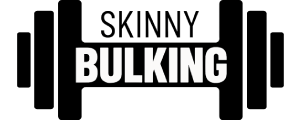For many people, getting bigger and stronger is a top priority. However, the fear of gaining unwanted fat can deter many from reaching their goals. Though bulking up requires a caloric surplus, there are ways to do it without gaining too much body fat. It’s all about being smart with your diet and training. In this post, we’ll discuss three tips that will help you to bulk up without adding too much fat. From monitoring your macronutrient intake to implementing the right kind of cardio, we’ll give you the tools you need to achieve your goals while avoiding the extra pounds. Whether you’re a competitive athlete or just looking to build some muscle, these tips will help you achieve the results you desire.
1. Why you might want to bulk up and why it’s important to do it the right way
Many people have a misconception that bulking up means gaining a lot of fat. However, this is not true. Bulking up is a process where you increase your calorie intake to gain muscle mass while minimizing fat gain. It’s important to understand why you might want to bulk up before embarking on this journey.
Firstly, bulking up helps to increase muscle mass, which in turn increases strength, endurance, and overall fitness levels. This is especially important for individuals who are involved in sports or physical activities that require a certain level of physical fitness.
Secondly, bulking up can help to improve your body composition. By increasing muscle mass and reducing body fat percentage, you can achieve a lean and toned physique that looks and feels great.
However, it’s important to do it the right way to avoid negative consequences such as gaining too much fat or putting too much strain on your body. This involves following a structured nutrition plan that provides the right amount of calories and nutrients to support muscle growth, as well as engaging in a consistent and challenging exercise routine that targets all major muscle groups. By doing so, you can bulk up effectively and achieve your fitness goals without compromising your health.
2. 3 tips for getting bigger without getting fat:

Image: pexels
When it comes to getting bigger without getting fat, there are a few key tips to keep in mind. First, focus on building lean muscle through strength training exercises. This will not only help you increase your muscle mass, but it will also boost your metabolism, helping you burn more calories throughout the day.
Another important tip is to pay attention to your diet. While you’ll need to consume more calories than you burn in order to gain weight, it’s important to focus on nutrient-dense foods that will support your muscle growth and overall health. This includes lean proteins, healthy fats, and complex carbohydrates like whole grains, fruits, and vegetables.
Finally, don’t forget about the importance of recovery. Adequate rest and recovery time between workouts is essential for allowing your muscles to repair and grow. This means getting enough sleep, taking rest days when needed, and incorporating techniques like foam rolling and stretching to help prevent injury and improve mobility.
By following these tips and staying consistent with your training and nutrition, you can bulk up and build muscle without gaining excess fat. With dedication and patience, you’ll soon see the results you’ve been working towards.
– Focus on progressive overload
When trying to bulk up, it’s important to focus on progressive overload. This means gradually increasing the weight or resistance you’re lifting over time. By doing this, you’re constantly challenging your muscles to adapt and grow stronger.
It’s important to note that progressive overload doesn’t just mean adding more weight to the bar every week. It can also mean increasing your reps or sets, decreasing your rest time between sets, or even changing up your exercises. The key is to keep challenging yourself in different ways to keep making progress.
One way to implement progressive overload is by using a training log. This will help you keep track of your progress and ensure that you’re consistently pushing yourself to lift more weight or perform more reps. It’s also a great way to identify any plateau in your progress and make adjustments to your training program.
Overall, focusing on progressive overload is a key factor in getting bigger without getting fat. By challenging yourself in different ways and gradually increasing the weight or resistance over time, you’ll be able to build muscle and achieve your goals.
– Track your calories and macros
One of the most important things to keep in mind when bulking up is to track your calories and macros. It’s incredibly easy to eat too much and end up gaining more fat than muscle, which is counterproductive to your goals.
To avoid this, use a calorie-tracking app or website to determine your daily caloric needs based on your weight, height, activity level, and goals. From there, you can adjust your daily intake to make sure you’re eating enough to support muscle growth without going overboard.
In addition to tracking your calories, it’s important to track your macronutrients (carbs, protein, and fat). This will help you make sure that you’re getting enough protein to support muscle growth and enough carbs to fuel your workouts, while still keeping your fat intake in check.
Remember, the goal is to gain muscle, not fat, so tracking your calories and macros is essential to making sure you’re on the right track. By doing so, you can make adjustments as needed to ensure that you’re fueling your body properly and getting the results you want.
– Incorporate high-intensity interval training (HIIT)
High-intensity interval training, or HIIT as it’s commonly known, is a fantastic way to build muscle without adding unnecessary fat. The beauty of HIIT is that it can be done with minimal equipment and in a short amount of time. The basic premise of HIIT is to perform short, intense bursts of exercise followed by periods of rest or low-intensity activity. This approach provides a range of benefits, such as an increase in anaerobic and aerobic fitness, improved insulin sensitivity, and greater fat burning capacity.
HIIT can be incorporated into any workout routine, whether it’s weightlifting or cardio-based. An example of a HIIT workout is sprinting for 30 seconds followed by a 30-second rest period, repeated for 10-15 minutes. This approach can also be applied to weightlifting by performing a set of exercises with a high weight for a short amount of time, followed by a rest period, and then repeated for several sets.
The key to successful HIIT training is to ensure that the intensity is high enough to stimulate muscle growth without causing excessive fatigue or muscle damage. Start with shorter intervals and gradually increase the duration and intensity as your fitness level improves. With consistent HIIT training, you’ll be able to bulk up without adding unwanted fat and achieve your fitness goals in no time.
3. How to focus on progressive overload and why it’s important
When it comes to building muscle, one of the key principles you need to understand and implement is progressive overload. This simply means that over time, you need to continually add more weight or reps to your exercises in order to challenge your muscles and force them to adapt and grow.
Progressive overload is important because your body is very good at adapting to stress. If you keep lifting the same weight for the same number of reps, your muscles will eventually stop growing because they have adapted to that level of stress. By gradually increasing the weight or reps, you keep challenging your muscles and forcing them to grow.
There are many ways to implement progressive overload in your workouts. One common method is to simply add weight to your exercises as you get stronger. For example, if you were squatting 100 pounds for 3 sets of 10 reps, you might add 5 pounds to the bar next week and aim for 3 sets of 10 again.
Another method is to increase the number of reps you perform with a given weight. For example, if you were bench pressing 135 pounds for 3 sets of 8 reps, you might aim for 3 sets of 10 reps next week.
Finally, you can also implement progressive overload by reducing your rest periods between sets. By doing this, you increase the overall workload on your muscles and force them to adapt and grow.
No matter how you choose to implement progressive overload in your workouts, the key is to make sure you are constantly challenging your muscles and pushing yourself to lift heavier weights or perform more reps over time. By doing this, you will see steady gains in muscle size and strength without gaining excess body fat.
4. How to track your calories and macros and why it’s important
Tracking your calories and macros is a crucial step when trying to bulk up without gaining excessive fat. The first thing you need to do is calculate your daily caloric needs. You can use a calorie calculator to determine your maintenance calories or the number of calories you need to consume to maintain your current weight. Once you have this number, you can add 250-500 calories to it to create a calorie surplus and promote muscle growth.
Next, you need to track your macros, which are the three main macronutrients: protein, carbohydrates, and fats. Protein is essential for building and repairing muscle tissue, while carbohydrates provide energy for your workouts and help with recovery. Fats are also important for overall health and hormone regulation.
Tracking your macros will help ensure that you’re consuming the right amount of each macronutrient for your body and your goals. There are many apps and websites available that make tracking your calories and macros easy.
By tracking your calories and macros, you can also ensure that you’re not overeating and gaining too much fat. It’s important to remember that a calorie surplus is necessary for muscle growth, but too much of a surplus can lead to excessive fat gain. By tracking your calories and macros, you can find the right balance and achieve your goals of getting bigger without getting fat.
5. How HIIT can help you bulk up without getting fat
High-Intensity Interval Training, or HIIT, is an excellent way to build muscle without adding unnecessary fat. HIIT workouts are designed to get your heart rate up and keep it there for a short period of time. During a HIIT session, you’ll work out at maximum intensity for a short period of time, followed by a recovery period.
The benefits of HIIT for bulking up without getting fat are twofold. First, HIIT workouts are designed to be high-intensity, which means that you’ll be burning a lot of calories during and after the workout. This helps to create a calorie deficit, which is essential for building muscle without adding fat.
Second, HIIT workouts are designed to increase your body’s production of growth hormone, which is essential for building muscle. Growth hormone helps to stimulate muscle growth and repair, which is essential for building muscle mass.
To incorporate HIIT into your workout routine, try adding 20-30 minutes of high-intensity intervals to your regular workout routine. This could include sprints, burpees, or other high-intensity exercises. You can also try incorporating HIIT into your weightlifting routine by performing your sets with less rest in between.
Overall, incorporating HIIT into your workout routine is an excellent way to build muscle without adding unnecessary fat. By creating a calorie deficit and increasing your body’s production of growth hormone, you’ll be well on your way to achieving your bulking goals.
6. The importance of rest and recovery

Image: pixabay
When it comes to building muscle, many people focus solely on the workouts and forget about the importance of rest and recovery. However, rest and recovery are just as crucial for muscle growth as exercise itself.
During weightlifting or resistance training, we create small micro-tears in our muscles. Rest and recovery give our muscles the time they need to repair these tears and grow stronger.
Without proper rest and recovery, we risk overtraining, injury, and even muscle loss. Overtraining can lead to decreased performance, fatigue, and increased risk of injury. Injuries can set us back in our fitness journey and even cause long-term damage.
To avoid these negative effects, make sure you prioritize rest and recovery. This can include getting enough sleep, taking rest days, and incorporating recovery activities such as foam rolling and stretching.
Additionally, proper nutrition is also an essential aspect of recovery. Make sure you are fueling your body with the right nutrients, including protein, to support muscle growth and recovery.
Remember, rest and recovery are not signs of weakness, but rather a crucial component of building muscle and achieving your fitness goals.
7. Frequently asked questions about bulking up
As with any topic, there are always frequently asked questions that come up about bulking up. Here are a few common ones and their answers:
1. Will I gain fat while bulking up?
While it is possible to gain some fat while bulking up, the goal should be to gain more muscle than fat. This can be achieved by following a structured workout program and monitoring your calorie intake.
2. Do I need to eat a lot of protein while bulking up?
Yes, protein is essential for building muscle. Aim for at least 1 gram of protein per pound of body weight per day. This can come from both food sources and protein supplements.
3. Can I still do cardio while bulking up?
Yes, cardio can help improve cardiovascular health and burn additional calories. However, it’s important to balance cardio with weightlifting to ensure you are still building muscle.
4. How long should I bulk up for?
This can vary depending on your goals and starting point. Generally, a bulking phase can last anywhere from a few months to a year. After that, it’s common to enter a cutting phase to lose any excess fat gained during the bulking phase.
5. Do I need to take supplements while bulking up?
While supplements are not necessary for bulking up, they can help support muscle growth and recovery. Popular supplements for bulking up include protein powder, creatine, and beta-alanine. It’s important to do your research and consult with a healthcare professional before starting any supplement regimen.
8. Mistakes to avoid when trying to bulk up
When it comes to bulking up, there are some common mistakes that people make that can hinder progress or even lead to unwanted weight gain. One of the biggest mistakes is not tracking your calorie intake. In order to gain muscle, you need to consume more calories than your body burns. However, it’s important to make sure you’re not consuming too many calories, which can lead to fat gain instead of muscle gain. Keeping a food diary or using a calorie tracking app can help you stay on track.
Another mistake is not getting enough protein. Protein is essential for building and repairing muscle tissue, so it’s important to consume enough of it. Aim for at least 1 gram of protein per pound of body weight per day. You can get protein from sources such as lean meats, fish, eggs, and protein supplements.
Finally, many people make the mistake of not getting enough rest. Your muscles need time to recover and grow after a workout, so it’s important to get enough sleep and take rest days between workouts. Overtraining can lead to injury and can actually hinder muscle growth. By avoiding these common mistakes, you can maximize your muscle-building potential and achieve your goals without getting fat.
9. Success stories and real-life examples
Success stories and real-life examples can be extremely motivating and inspiring when it comes to achieving your fitness goals. Many individuals have been able to bulk up without gaining excess fat, and their journeys can provide valuable insights and tips for others looking to do the same.
One such example is Arnold Schwarzenegger, who is widely regarded as one of the greatest bodybuilders of all time. Despite bulking up to massive proportions during his career, Arnold maintained a relatively low body fat percentage thanks to his commitment to both training and nutrition. He followed a strict diet that was high in protein and low in carbohydrates, and incorporated cardio into his routine to keep his body fat levels in check.
Another example is fitness influencer and bodybuilder Jeff Nippard, who has built a large following for his informative and research-based approach to training and nutrition. Jeff has emphasized the importance of tracking your progress and adjusting your diet and training plan accordingly in order to achieve your goals without gaining excess fat. He also advocates for incorporating a variety of exercises and training methods to keep your body challenged and prevent plateaus.
By seeking out success stories and real-life examples, you can gain valuable insights and inspiration for your own fitness journey. Whether it’s through following social media accounts of fitness influencers or reading biographies of successful bodybuilders, studying the strategies and techniques of those who have achieved success can provide valuable guidance in your own quest for gains without excess fat.
10. Conclusion and final thoughts.
In conclusion, getting bigger without getting fat is not impossible, but it does take work and discipline. Incorporating a combination of strength training, cardiovascular exercise, and a well-balanced diet can help you build muscle mass while keeping body fat at bay. Remember to focus on progressive overload, meaning gradually increasing the weights you lift or the number of reps you perform, to continually challenge your muscles and avoid plateauing.
Moreover, don’t forget to prioritize recovery, such as getting enough sleep, stretching, and foam rolling, to prevent injuries and optimize muscle growth. And finally, a positive mindset and consistency are key to achieving your fitness goals. It’s important to stay motivated, track your progress, and celebrate your successes along the way.
By following these tips and staying committed to your fitness journey, you can bulk up in a healthy and sustainable way, and achieve the physique you desire. So, start implementing these tips into your routine today, and see the results for yourself!







Leave a Reply